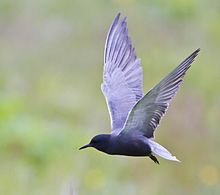- Black Tern
-
Black Tern 
Conservation status Scientific classification Kingdom: Animalia Phylum: Chordata Class: Aves Order: Charadriiformes Family: Sternidae Genus: Chlidonias Species: C. niger Binomial name Chlidonias niger
(Linnaeus, 1758)Subspecies - C. n. niger
(Eurasian Black Tern) - C. n. surinamensis
(North American Black Tern)
The Black Tern, Chlidonias niger, is a small tern generally found in or near inland water in Europe and North America. As its name suggests, it has predominantly dark plumage.
Contents
Description
Adult are 25 cm (9.75 in) long, with a wing span 61 cm (24 in), and weigh 62 g (2.2 oz). They have short dark legs and a short, weak-looking black bill, measuring 27–28 mm, nearly as long as the head. The bill is long, slender, and looks slightly decurved. They have a dark grey back, with a white forehead, black head, neck (occasionally suffused with gray in the adult) and belly, black or blackish-brown cap (which unites in color with the ear coverts, forming an almost complete hood), and a light brownish-grey, 'square' tail. The face is white. There is a big dark triangular patch in front of the eye, and a broadish white collar in juveniles. There are grayish-brown smudges on the ides of the white breast, a downwards extension of the plumage of the upperparts. These marks vary in size and are not conspicuous. In non-breeding plumage, most of the black, apart from the cap, is replaced by grey. The plumage of the upperparts is drab, with pale feather-edgings. The rump is brownish-gray.
The North American race, C. n. surinamensis, is distinguishable from the European form in all plumages, and is considered by some to be a separate species.
In flight, the build appears slim. The wing-beats are full and dynamic, and flight is often erratic as it dives to the surface for food; similar to other tern species.
Hybridisation with White-winged Black Tern
Hybridisation between this species and White-winged Black Tern has been recorded from Sweden[2] and the Netherlands.[3] Two juvenile birds at Chew Valley Lake, England, in September 1978 and September 1981, were also believed to be hybrids; they showed mixed characters of the two species, specifically a combination of a dark mantle (a feature of White-winged Black) with dark patches on the breast-side (a feature of Black Tern, not shown by White-winted Black).[4][5]
Distribution and habitat
Their breeding habitat is freshwater marshes across most of Canada, the northern United States and much of Europe and western Asia. They usually nest either on floating material in a marsh or on the ground very close to water, laying 2-4 eggs.
North American Black terns migrate to the coasts of northern South America, some to the open ocean. Old World birds winter in Africa.
Unlike the "white" Sterna terns, these birds do not dive for fish, but forage on the wing picking up items at or near the water's surface or catching insects in flight. They mainly eat insects and fish as well as amphibians.
Vagrancy
The American race has occurred as a vagrant in Britain[6][7] and in Ireland.[8][9][10]
Conservation
The North American population has declined in recent times due to loss of habitat.
Point Pelee National Park in Canada boasts a robust population of black terns.
The Black Tern is one of the species to which the Agreement on the Conservation of African-Eurasian Migratory Waterbirds (AEWA) applies.
References
- ^ BirdLife International (2004). Chlidonias niger. 2006. IUCN Red List of Threatened Species. IUCN 2006. www.iucnredlist.org. Retrieved on 9 May 2006. Database entry includes justification for why this species is of least concern
- ^ (Swedish) Alexandersson, H. (1979) En hybridisering mellan vitvingad tärna Childonias leucopterus och svarttärna Childonias niger på Öland 1978 Calidris 8: 151-53
- ^ (Dutch) Van IJzendoorn, E. J. (1980) Broedgeval van Zwarte Childonias niger × Witvleugelstern C. leucopterus Dutch Birding 2: 62-65
- ^ Vinicombe, Keith (1980) Tern showing mixed characters of Black Tern and White-winged Black Tern British Birds 73(5): 223-25
- ^ Davis, A. H. (1980) Tern showing mixed characters of Black and White-winged Black Tern British Birds 75(12): 579-80
- ^ Andrews, Richard, Rupert Higgins and John Martin (1999) The American Black Tern in Avon Birding World 12(10): 416-18 (an account of the first British record)
- ^ Andrews, R. M., R. J. Higgins and J. P. Martin (2006) American Black Tern at Weston-super-Mare: new to Britain British Birds 99(9): 450-59
- ^ Adriaens, Peter (1999) The American Black Tern in County Dublin Birding World 12(9): 378-79
- ^ Bradshaw, Colin (2003) The American Black Tern in County Kerry Birding World 16(10): 434
- ^ Mullarney, Killian (2003) The American Black Tern in Co. Wexford Birding World 19(7): 279-82
- "National Geographic" Field Guide to the Birds of North America ISBN 0-7922-6877-6
- Seabirds, an Identification Guide by Peter Harrison, ISBN 0-7470-1410-8
- Handbook of the Birds of the World Vol 3, Josep del Hoyo editor, ISBN 84-87334-10-5
- "National Audubon Society" The Sibley Guide to Birds, by David Allen Sibley, ISBN 0-679-45122-6
External links
- Black Tern Childonias niger - USGS Patuxent Bird Identification InfoCenter
- Black Tern Species Account - Cornell Lab of Ornithology
- Black Tern Information and Photos - South Dakota Birds and Birding
- Avibase
Categories:- IUCN Red List least concern species
- Chlidonias
- Birds of India
- Birds of North America
- Birds of Europe
- Birds of Turkey
- Birds of Puerto Rico
- Birds of Africa
- Birds of South Africa
- C. n. niger
Wikimedia Foundation. 2010.


